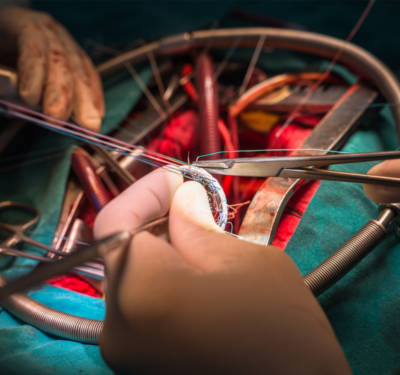Fixing a heart valve
Repairing a defective heart valve may be a better option than replacing it.
Published online 30 September 2015

A suture valve ring is used during mitral valve repair surgery.
© chanawit sitthisombat / Alamy Stock Photo
Mitral valve repair is an effective but widely unrecognized treatment for rheumatic heart disease in developing countries, according to research published recently in the Global Cardiology Science and Practice journal1.
Rheumatic fever and carditis are characterized by cardiac inflammation and scarring, which narrows the valves in the heart and restricts the flow of blood through them. These conditions are a major public health issue in many parts of the world, and in economically developed countries are usually treated by a surgical procedure to replace the damaged heart valve.
In developing countries, however, patients are often poor and uneducated, have difficulty accessing medical care, and do not comply with treatment or therapy. All of these factors significantly increase the rate of complications following valve replacement, so valve repair is a more viable option in these parts of the world.
Cardiothoracic surgeon Michael Antune of the University Hospital and Faculty of Medicine in Coimbra, Portugal, analyzed the treatment of rheumatic heart disease, focusing on the methods and results of valve repair. His analysis suggests that valve repair is not only feasible, but also produces better outcomes.
Of the nearly 1,900 rheumatic carditis patients operated on in his own department between 1992 and 2012, Antunes reports that over 1,500 (or nearly 81%) underwent a valve repair procedure, with nearly 90% of those surviving for 15 years or more without having to return for another operation. Surgeons in other parts of the world, including India, Brazil and South Africa, confirm that valve repair produces excellent long-term survival rates, even in younger patients.
It seems clear that valve repair is the procedure of choice for treating patients in underprivileged countries. And yet, surgeons are often unwilling to repair the mitral valve, because the procedure is more challenging than valve replacement.
As Antune points out, however, the proportion of repaired valves that need to be replaced later on decreases with surgeons' increasing experience of the procedure. Raising surgeons' awareness of how effective the procedure is, and encouraging them to gain more experience in performing it, could improve outcomes for rheumatic heart disease patients in the developing world.
Reference
Antunes, M. J. Challenges in rheumatic valvular disease: surgical strategies for mitral valve preservation. Glob. Cardiol. Sci. Practice 2015, 9 (2015). | article
DOI: 10.1038/qsh.2015.81

